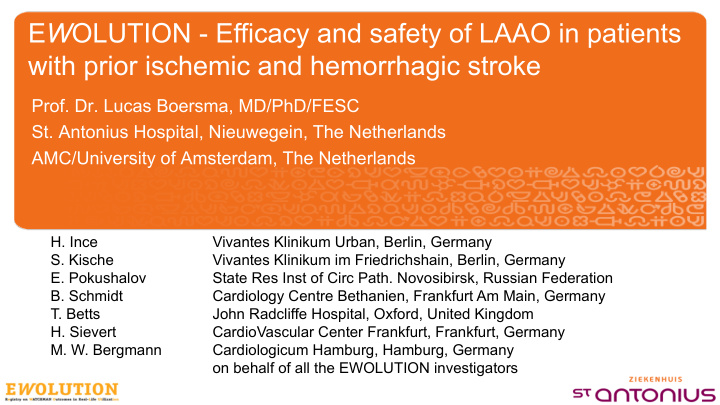



E W OLUTION - Efficacy and safety of LAAO in patients with prior ischemic and hemorrhagic stroke Prof. Dr. Lucas Boersma, MD/PhD/FESC St. Antonius Hospital, Nieuwegein, The Netherlands AMC/University of Amsterdam, The Netherlands H. Ince Vivantes Klinikum Urban, Berlin, Germany S. Kische Vivantes Klinikum im Friedrichshain, Berlin, Germany E. Pokushalov State Res Inst of Circ Path. Novosibirsk, Russian Federation B. Schmidt Cardiology Centre Bethanien, Frankfurt Am Main, Germany T. Betts John Radcliffe Hospital, Oxford, United Kingdom H. Sievert CardioVascular Center Frankfurt, Frankfurt, Germany M. W. Bergmann Cardiologicum Hamburg, Hamburg, Germany on behalf of all the EWOLUTION investigators
Registry on WATCHMAN Outcomes in Real-Life Utilization: E W OLUTION Study Objective: Collect real-world WATCHMAN LAAO experience outside of selected populations in prior RCT Study Design: Prospective, single-arm, multi-center registry of the Watchman LAA Closure Technology Primary Endpoint: Primary analysis includes procedural success and safety, incidence of stroke, bleeding, and death after 2 yr of FU Investigator and Medical Safety Group for adjudication Patient Population: >1000 patients Number of Sites: 47 throughout Europe, Russia and Middle East Enrollment: Started October 2013 - Completed May 2015 Standard practice at participating centers • Normally 1-3 months post-procedure Follow-up: • Annually thereafter for a total of 2 years Boersma et al. Cath Card Int 2015
E W OLUTION – complete 2 year patient flow Informed consent obtained: N = 1025 Anatomy considered not suitable at prescreening: N = 5 Study population Implant of WATCHMAN: N = 1020 End of study < 1 year (N = 221) Patients with successful Watchman implant: Deceased: N = 161 N = 1005 Withdrawn: N = 18 Lost to FU: N = 42 Pts with completed 2 yrs FU: N = 784/1005 (78%) Pts with CT/TEE: N = 835/1005 (83%) Total #CT/TEEs: N = 1145 (avg 1.4/pt)
E W OLUTION – Stroke risk profile in AF patients CHA 2 DS 2 -VASc distribution in EWOLUTION CHA 2 DS 2 -VASc score ≥ 5 49% 250 200 HAS-BLED ≥ 3 40% Nr pts 150 Major Bleeding/predisposition bleeding 39% 100 50 Contra-indication (N)OAC 73% 0 0 1 2 3 4 5 6 7 8 9 Expected ischemic strokes per 100 PY 16 14.4 based on CHA 2 DS 2 -VASc (Friberg) 14 13.1 12.6 Treated with ASA 12.2 11.4 12 11.2 10.8 Untreated 9.7 10 8.4 8 7.2 5.5 6 4.8 3.7 4 3.2 2.5 2.2 2 0.6 0.6 0.2 0.2 0 0 1 2 3 4 5 6 7 8 9
E W OLUTION – OAT at Follow-Up 71% Pts with known medication: N = 998 58% Pts without FU information: N = 52 60% 14% Pts with first medication change info: N = 946 26% 7% 8% 8% 27% 6% 8% 7% 2-YR FU FIRST CHANGE None IMPLANT SAPT DAPT (N)OAC IMPLANT FIRST CHANGE 2-YR FU After 2 years 85% of pts were on SAPT or nothing
Time to final single APT or nothing Kaplan-Meier Time Event Rate 45 Days 8.3% 3 months 23.6% 6 months 45.5% 1 year 75.0% 2 years 95.1%
E W OLUTION – High risk subgroup characteristics CHA 2 DS 2 -VASc single/ none HAS-BLED (N)OAC DAPT Post implant medications N EWOLUTION all pts 1020 4.5 2.3 27% 14% 60% Hx ischemic stroke/TIA 311 5.5 2.6 29% 15% 56% 11% * Hx hemorrhagic stroke 153 5.4 2.8 27% 62% Hx Major Bleed 318 4.8 3.2 15% 17% 67% * More pts on SAPT/none p<0.001)
Device thrombus and medication – no relation P = 0.208 6.0% 4.9% 4.8% 4.5% 5.0% 4.0% 3.0% 2.0% 2.0% 0.8% 1.0% 0.0% VKA NOAC DAPT single None APT
E W OLUTION – Thrombo-embolic event rates
E W OLUTION – No Stroke/TIA/SE in low risk patients N = 902 N = 118
E W OLUTION – Stroke in high risk subgroups 12 CHA 2 DS 2 - CHA 2 DS 2 - CHA 2 DS 2 - CHA 2 DS 2 - Thromboembolic events /100 pt- VASc VASc VASc VASc 10 4.5 5.5 5.4 4.8 9.5 9.3 8 7.8 7.2 76% 81% 6 yrs RRR RRR 85% 83% RRR 4 RRR 2 2.3 1.8 1.3 1.2 0 EWOLUTION all Hx stroke/TIA Hx hemorrhagic Hx Major Bleed (N=1020) (N=311) stroke (N=153) (N=318)
E W OLUTION – Stroke/TIA/TE in high risk subgroups CHA 2 DS 2 - CHA 2 DS 2 - VASc VASc 5.5 CHA 2 DS 2 - 5.4 CHA 2 DS 2 VASc -VASc 4.8 4.5
E W OLUTION – Bleeding rates for all pts N = 1020
EWOLUTION – Bleeding in high risk subgroups HAS-BLED HAS-BLED HAS-BLED HAS-BLED 7 2.3 2.6 2.8 3.2 6.5 6 30% Major Bleedings /100 pt-yrs RRR 5.6 5.4 5 5.0 41% 4.5 RRR 46% 4 67% RRR RRR 3 3.2 2.7 2 1.8 1 0 EWOLUTION all Hx stroke/TIA Hx hemorrhagic Hx Major Bleed (N=1020) (N=311) stroke (N=153) (N=318)
Consistent low stroke rate with WATCHMAN
EWOLUTION - Conclusions WATCHMAN LAAC was studied in an all-comers prospective registry with >70% • of pts contra-indicated to oral anticoagulation Implant and LAA sealing success exceeding that of prior RCT and registries, with • lower procedural adverse event rates 1 During the complete 2-year follow-up: Most pts were on (D)APT (77%) or no anticoagulation (14%) • Device-thrombus was low (4.1%) and unrelated to stroke or anticoagulation type • Ischemic stroke rate was 1.3 per 100 pt-yrs (83% RR reduction) • Post-procedural major bleeding was 2.7 per 100 pt-yrs (46% RR reduction) • High risk pts with prior ischemic/hemorrhagic stroke had the same benefit of • stroke/TIA/SE prevention and the same low bleeding rates 1. Boersma et al. EHJ 2016
THANK YOU
Recommend
More recommend